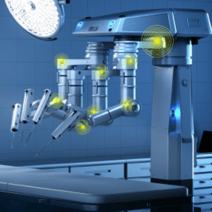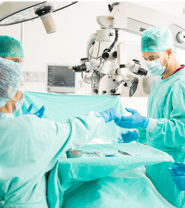Three Known Pain Points Slowing Surgical Robotics Adoption
Robotic technology is opening new doors in the surgical world. The shift is providing benefits for both surgeons and patients, including improved precision and accuracy, ergonomics, and dexterity. Patients are receiving lower risks of infections, better recovery times, and fewer complications. This technological shift to surgical robotics is also proving some limitations. Here are three common challenges faced in the adoption of surgical robotic technology:
Issues Still Hindering Surgical Robotics
- Haptic feedback: the physical sensation humans receive through our sense of touch, allowing the replication of sensorial feedback. While robotic surgery has substantial benefits, one significant drawback is that robotic surgery cuts out almost all haptic feedback that traditional surgical procedures have as surgeons are performing procedures with their own hands.
- Reliability: another limiting issue facing the adoption of surgical robots. Constant maintenance and unplanned downtime not only creates reliability risks due to safety and accuracy issues but can cost organizations up to $700 per minute!
- Complex and long training: this is proving to be a challenge for surgical robotic adoption. In addition to a general lack of academic training and steep learning curves with this technology, the team must undergo extensive training and get comfortable with the absence/significant reduction of tactile cues and kinesthetic signals.
Our Focus Areas on Solving these Pain Points

- Digital Solutions: Real-time monitoring with the Internet of Things (IoT) can limit downtime as progressing issues can be caught and fixed before a machine is out of service. Augmented Reality (AR) can provide not only maintenance instructions and assistance but also training opportunities.
- Industrial Design & Product Redesign: Our industrial design methodology goes deeper than product aesthetics to cover internal technology and manufacturability (DFX). We combine form, function, and features through our system-level approach to product innovation. We work on products with project engineering and industrial design together.
- Embedded Systems & Sensors: Custom hardware and software that solves a problem -- decreasing product size, increasing speed, improving accuracy and reliability, and more. Boston Engineering develops custom drives, algorithms, and application code including sensored control.
For almost three decades, Boston Engineering has designed, developed, and optimized devices and technologies the medical community relies on to save lives, enrich quality of life, and reduce costs to the healthcare system. We provide solutions to the challenges in the adoption of surgical robotics.
Our expertise includes industrial design and product redesign, sensors and control systems, robotics technical innovation, and digital software solutions.
Imagine your Impact: Stay up-to date- with the latest insights and trends we're watching. Add your email address below and sign up for a monthly summary of our most impactful posts!












